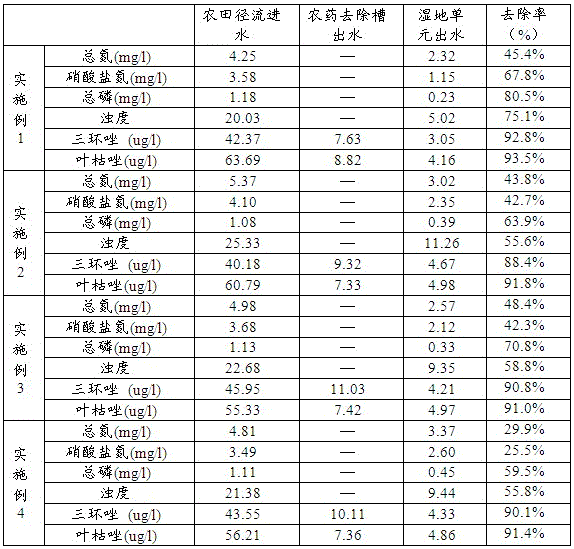A sea cauliflower macrobenthic economic wetland system to purify farmland runoff
A technology for benthic animals and sea cauliflower, which is applied in chemical instruments and methods, water/sewage multi-stage treatment, water/sludge/sewage treatment, etc., can solve the problem of high cost, and meet the requirements of high edible value and water body nutrient content. Low, improve the effect of underwater light and dissolved oxygen
- Summary
- Abstract
- Description
- Claims
- Application Information
AI Technical Summary
Problems solved by technology
Method used
Image
Examples
Embodiment 1
[0033] The constructed wetland system used to deal with farmland runoff described in this embodiment is as follows: figure 1 As shown, it includes a water inlet tank 1 , a pesticide removal tank 2 connected to the water outlet of the water inlet tank 1 , and a wetland unit 3 connected to the water outlet of the pesticide removal tank 2 . Wherein, the length of the tank body of the pesticide removal tank 2 is 1.2m, and the depth is 0.9m. The tank body of the pesticide removal tank 2 is filled with straw, and the thickness of the straw is 0.8m. The stalks in this embodiment are pieces of corn stalks with a length less than 3 cm, and the density of the stalks filled in the tank is 210 kg / m³.
[0034] The bottom of the wetland unit 3 is sequentially provided with a clay waterproof layer 7, a substrate layer 4 and a flooded layer from bottom to top, wherein the thickness of the clay layer is 30 cm, the thickness of the substrate layer 4 is 20 cm, and the flooded The depth of the ...
Embodiment 2
[0039] The constructed wetland system used to deal with farmland runoff described in this embodiment is as follows: figure 1 As shown, it includes a water inlet tank 1 , a pesticide removal tank 2 connected to the water outlet of the water inlet tank 1 , and a wetland unit 3 connected to the water outlet of the pesticide removal tank 2 . Wherein, the length of the tank body of the pesticide removal tank 2 is 3m, and the depth is 1.5m. The tank body of the pesticide removal tank 2 is filled with straw, and the thickness of the straw is 1.2m. The straw in this embodiment is soybean straw fragments with a length less than 3 cm, and the density of the straw filled in the tank is 220 kg / m³.
[0040] The bottom of the wetland unit 3 is sequentially provided with a clay waterproof layer 7, a substrate layer 4 and a flooded layer from bottom to top, wherein the thickness of the clay layer is 6 cm, the thickness of the substrate layer 4 is 20 cm, and the flooded The depth of the laye...
Embodiment 3
[0045] The constructed wetland system used to deal with farmland runoff described in this embodiment is as follows: figure 1 As shown, it includes a water inlet tank 1 , a pesticide removal tank 2 connected to the water outlet of the water inlet tank 1 , and a wetland unit 3 connected to the water outlet of the pesticide removal tank 2 . Wherein, the length of the tank body of the pesticide removal tank 2 is 1.2m, and the depth is 0.9m. The tank body of the pesticide removal tank 2 is filled with straw, and the thickness of the straw is 0.8m. The straw in this embodiment is rice straw fragments with a length less than 3 cm, and the density of the straw filled in the tank is 220 kg / m³.
[0046] The bottom of the wetland unit 3 is sequentially provided with a clay waterproof layer 7, a substrate layer 4 and a flooded layer from bottom to top, wherein the thickness of the clay layer is 20 cm, and the thickness of the substrate layer 4 is 5.5 cm. The depth of the water layer was...
PUM
| Property | Measurement | Unit |
|---|---|---|
| length | aaaaa | aaaaa |
| density | aaaaa | aaaaa |
| thickness | aaaaa | aaaaa |
Abstract
Description
Claims
Application Information
 Login to View More
Login to View More - R&D
- Intellectual Property
- Life Sciences
- Materials
- Tech Scout
- Unparalleled Data Quality
- Higher Quality Content
- 60% Fewer Hallucinations
Browse by: Latest US Patents, China's latest patents, Technical Efficacy Thesaurus, Application Domain, Technology Topic, Popular Technical Reports.
© 2025 PatSnap. All rights reserved.Legal|Privacy policy|Modern Slavery Act Transparency Statement|Sitemap|About US| Contact US: help@patsnap.com


